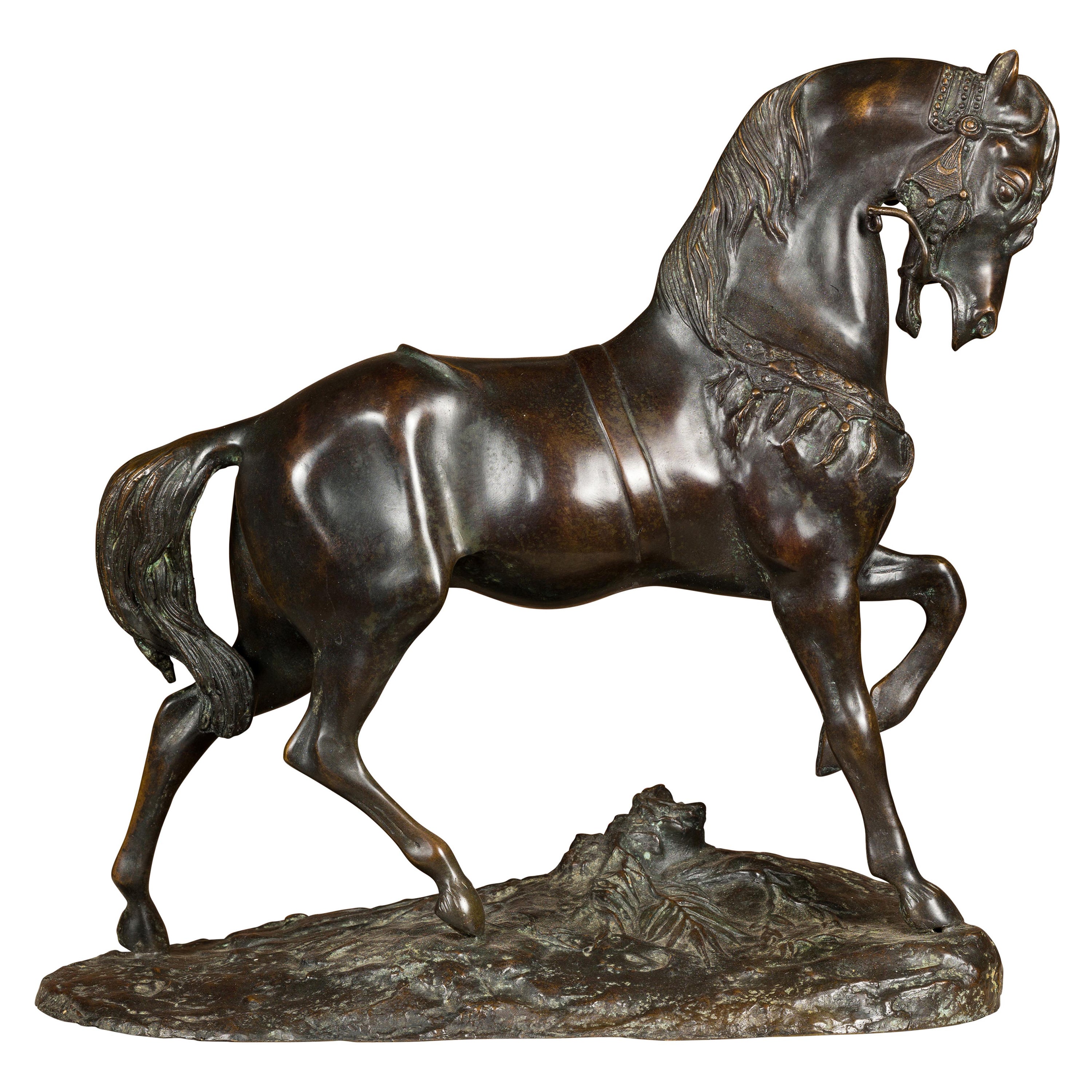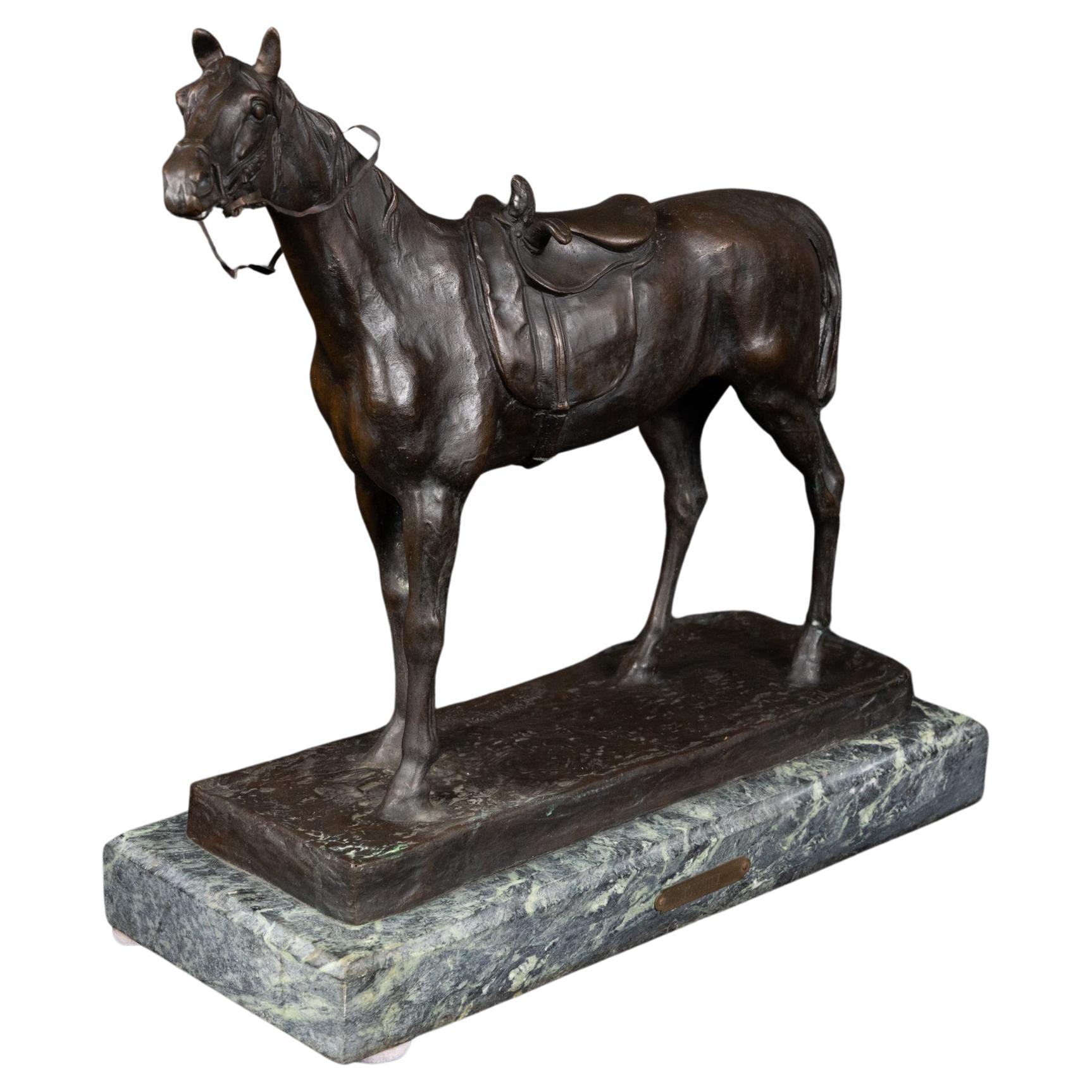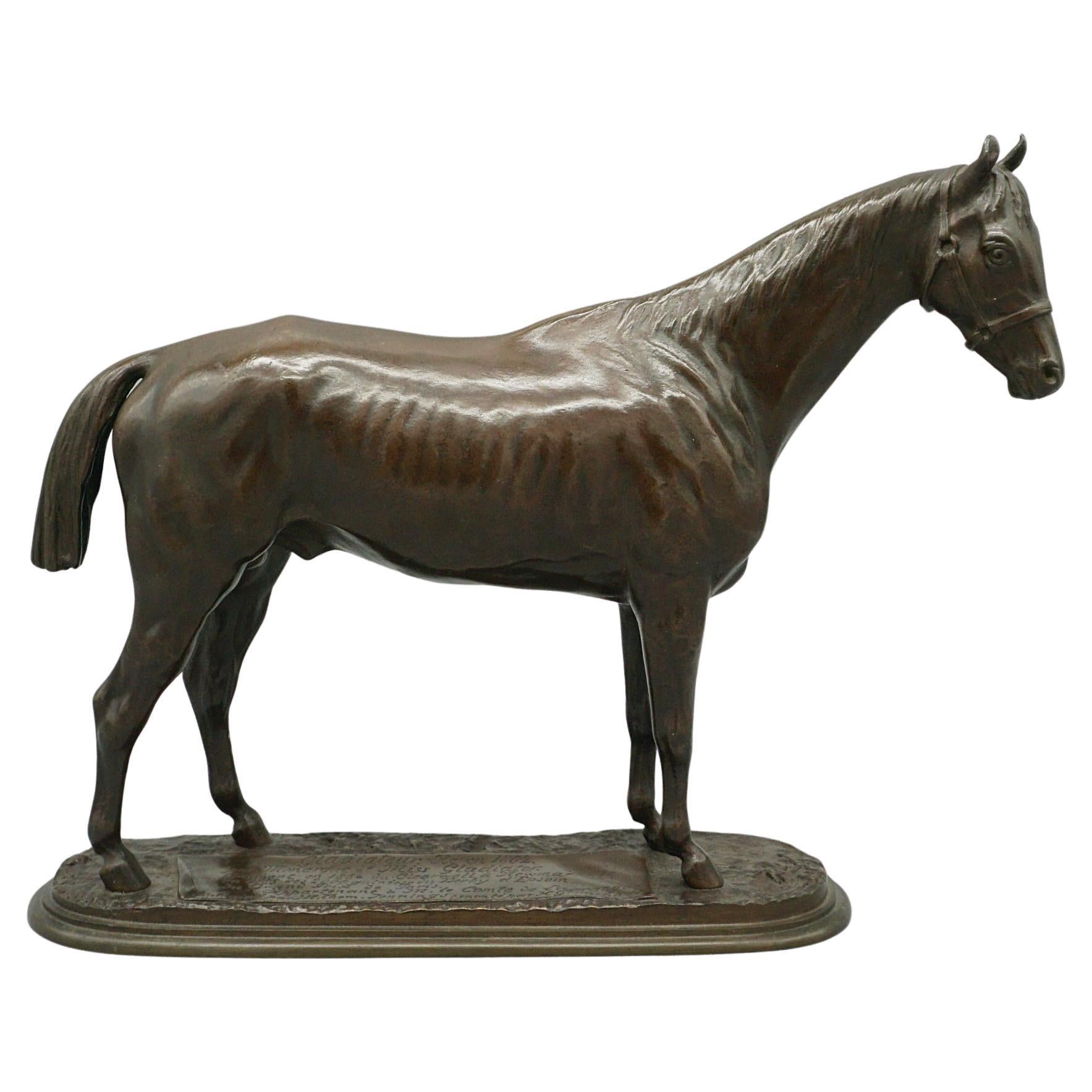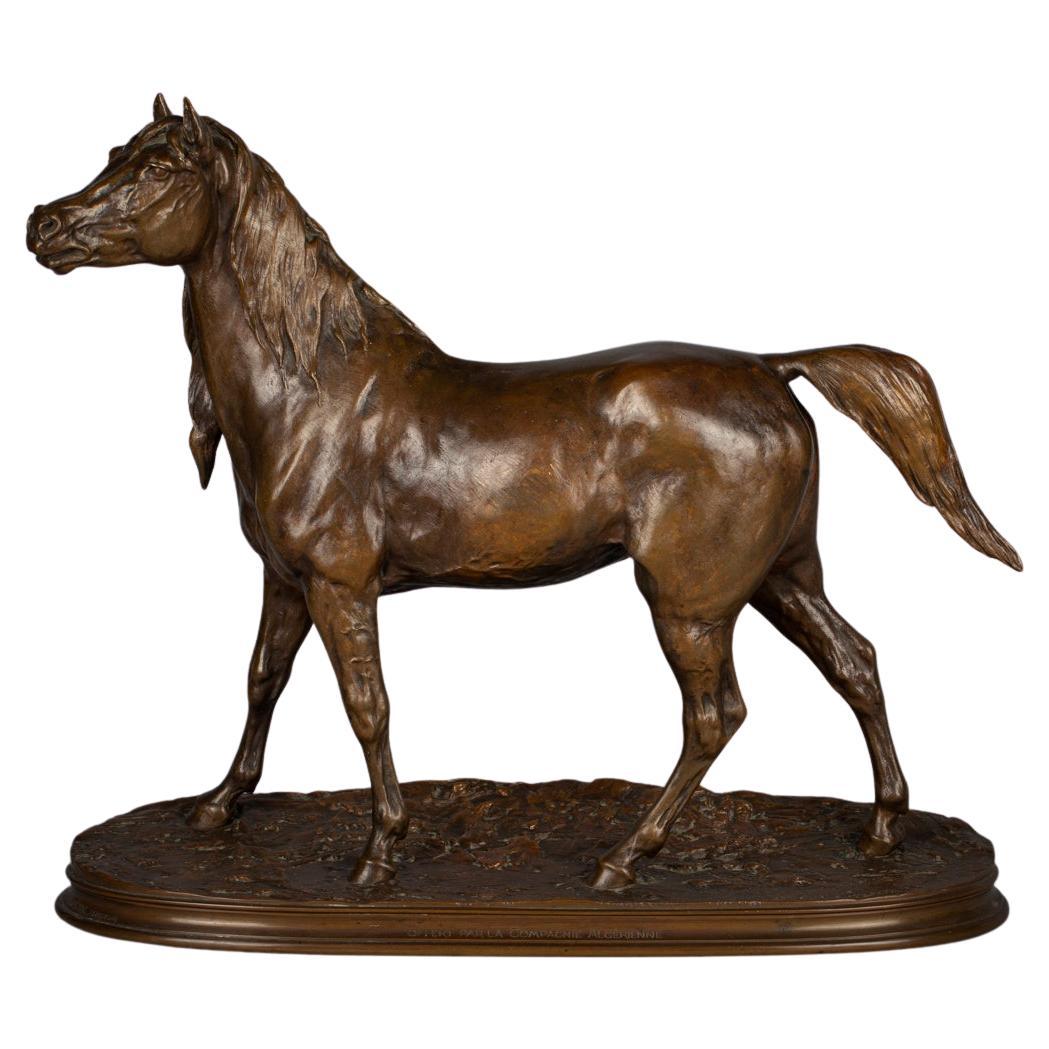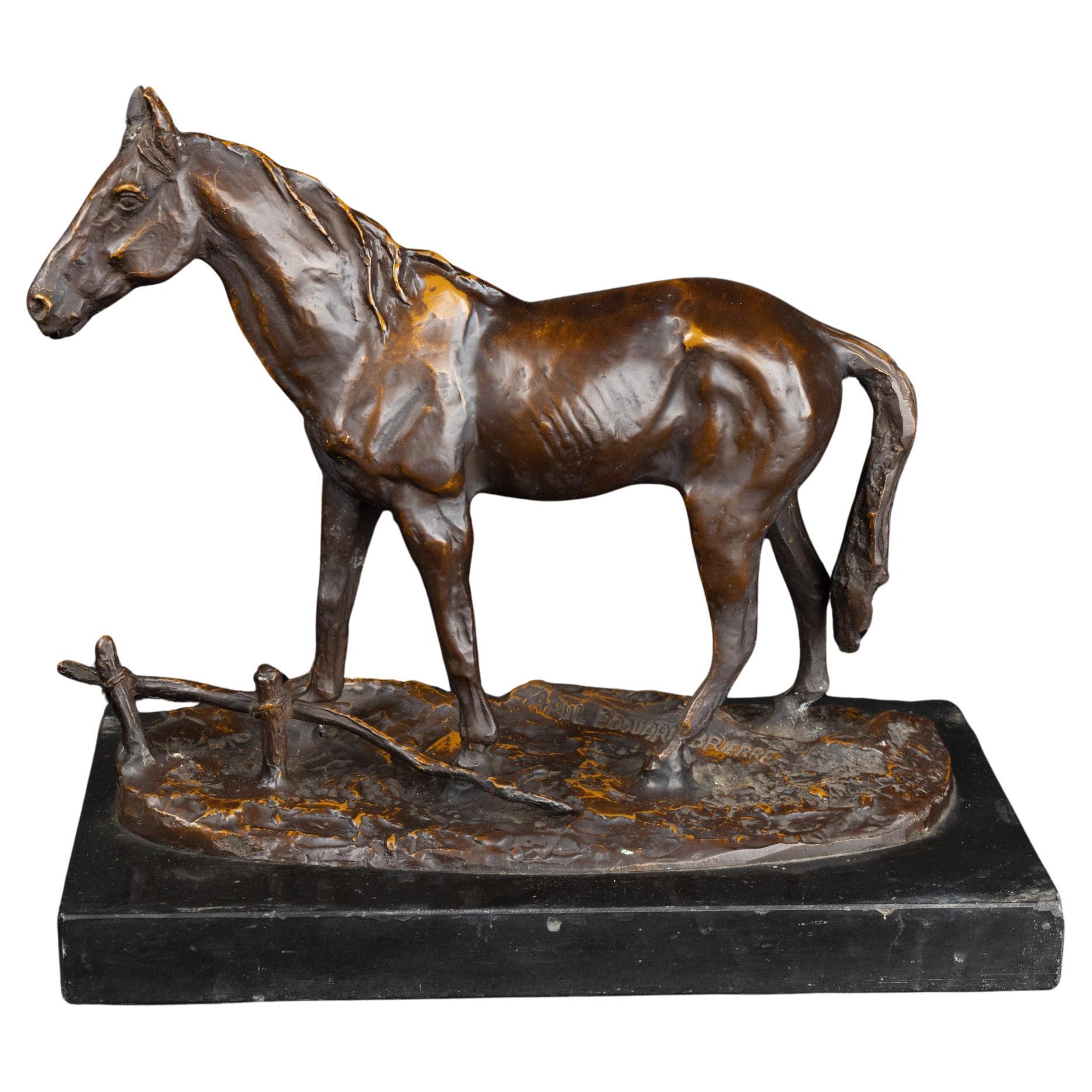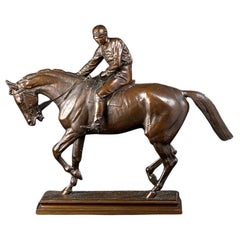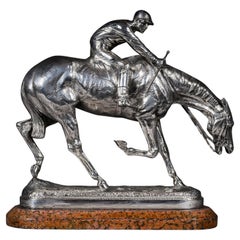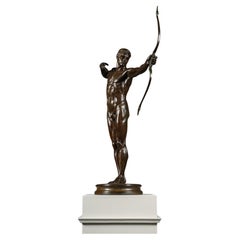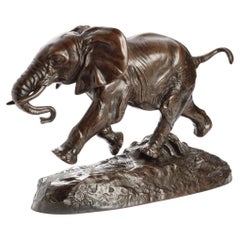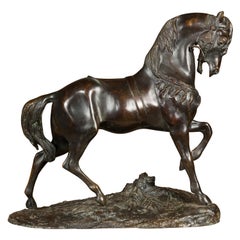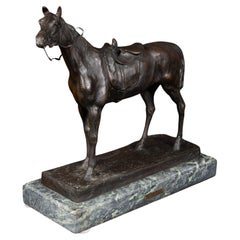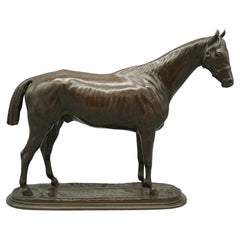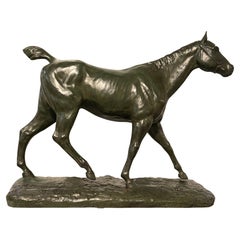Items Similar to Patinated Bronze Statue Of ‘A Horse Calling’, By Isidore-Jules Bonheur
Want more images or videos?
Request additional images or videos from the seller
1 of 11
Patinated Bronze Statue Of ‘A Horse Calling’, By Isidore-Jules Bonheur
$38,635.32
£28,000
€32,911.42
CA$52,546.70
A$58,878.29
CHF 30,648.39
MX$720,285.35
NOK 389,024.62
SEK 367,429.10
DKK 245,690.49
Shipping
Retrieving quote...The 1stDibs Promise:
Authenticity Guarantee,
Money-Back Guarantee,
24-Hour Cancellation
About the Item
A Large Patinated Bronze Statue Of ‘A Horse Calling’, By Isidore-Jules Bonheur (French, 1827 – 1901).
Bronze with a dark brown patina, on a veined green marble base.
Signed ‘I. BONHEUR’ and with the foundry stamp ‘PEYROL’.
France, Circa 1880.
The animalier sculptor Isidore-Jules Bonheur, was especially prized for his closely observed and lifelike modelling of horses. His accomplishment is especially evident in the present composition of ‘A Horse Calling’. It is all the more impressive because it is wrought on an unusually large scale. Most of Bonheur’s output in bronze sculpture is of small statues of animals for placement on a desk or bookshelf, whereas the present statue is of ‘trophy size’, measuring nearly three feet across. Bonheur expertly captures the instinctive nature and tension of this horse as it calls out, fully animating the modelling, with pricked ears, flared nostrils and tensed muscles and sinews to its face and neck.
- Creator:Isidore Jules Bonheur (Sculptor)
- Dimensions:Height: 28.35 in (72 cm)Width: 35.44 in (90 cm)Depth: 9.06 in (23 cm)
- Materials and Techniques:Bronze,Patinated
- Place of Origin:
- Period:
- Date of Manufacture:Circa 1880
- Condition:Wear consistent with age and use.
- Seller Location:Brighton, GB
- Reference Number:Seller: B782901stDibs: LU1028045344072
About the Seller
5.0
Recognized Seller
These prestigious sellers are industry leaders and represent the highest echelon for item quality and design.
Established in 1964
1stDibs seller since 2014
58 sales on 1stDibs
Typical response time: 3 hours
Associations
The British Antique Dealers' AssociationLAPADA - The Association of Arts & Antiques Dealers
- ShippingRetrieving quote...Shipping from: Brighton, United Kingdom
- Return Policy
Authenticity Guarantee
In the unlikely event there’s an issue with an item’s authenticity, contact us within 1 year for a full refund. DetailsMoney-Back Guarantee
If your item is not as described, is damaged in transit, or does not arrive, contact us within 7 days for a full refund. Details24-Hour Cancellation
You have a 24-hour grace period in which to reconsider your purchase, with no questions asked.Vetted Professional Sellers
Our world-class sellers must adhere to strict standards for service and quality, maintaining the integrity of our listings.Price-Match Guarantee
If you find that a seller listed the same item for a lower price elsewhere, we’ll match it.Trusted Global Delivery
Our best-in-class carrier network provides specialized shipping options worldwide, including custom delivery.More From This Seller
View All‘Le Grand Jockey ‘I by Sidore Jules Bonheur
By Isidore Jules Bonheur
Located in Brighton, West Sussex
Isidore Jules Bonheur (French, 1827-1901)
‘Le Grand Jockey ‘
Signed 'I Bonheur' and with foundry stamp PEYROL EDITEUR'.
Bronze, rich mid-brown pa...
Category
Antique 19th Century French Animal Sculptures
Materials
Bronze
John Willis-Good, ‘After The Race’, A Silvered Bronze Equestrian Group
By John Willis Good
Located in Brighton, West Sussex
John Willis-Good (British, 1845 - 1879)
‘After The Race’.
A Silvered Bronze Equestrian Group Cast By Elkington & Co, Birmingham.
Depicting a racehorse with jockey up, at the dynam...
Category
Antique 19th Century English Animal Sculptures
Materials
Slate, Bronze
A Patinated Bronze Statue Of Teucer, By Sir William Hamo Thornycroft
By William Hamo Thornycroft
Located in Brighton, West Sussex
Sir William Hamo Thornycroft (British, 1850-1925)
A Patinated Bronze Statue Of Teucer
The standing figure of the male nude holding his bow in his outstretched left hand, raised on a...
Category
Antique 19th Century English Neoclassical Figurative Sculptures
Materials
Bronze
Antoine Louis Barye, Bronze Model of 'Elephant De Senegal'
By Antoine-Louis Barye, Ferdinand Barbedienne
Located in Brighton, West Sussex
Antoine-Louis Barye (French, 1795-1875).
‘Éléphant du Sénégal’ (‘Senegalese Elephant’).
Patinated bronze.
Cast by Ferdinand Barbedienne, Paris, from the model by Antoine-Louis B...
Category
Antique 19th Century French Animal Sculptures
Materials
Bronze
Antoine Louis Barye (1795-1875), ' Theseus fighting the centaur Bianor'
By Antoine-Louis Barye
Located in Brighton, West Sussex
A Fine Patinated Bronze Group, Entitled 'Thesée Combattant le Centaure Bianor' ('Theseus Fighting the Centaur Bianor'), Cast by Ferdinand Barbedienne, From the Model By Antoine Louis...
Category
Antique 19th Century French Classical Greek Figurative Sculptures
Materials
Bronze
Pair of Bronze Models of a Standing Bull and a Running Cow, circa 1890
By Francois Auguste Hippolyte Peyrol 1, Isidore Jules Bonheur
Located in Brighton, West Sussex
A pair of large and finely patinated bronze models of a standing bull and a running cow after models by Isidor-Jules Bonheur, Cast on a Naturalistic Base.
French, circa 1890.
Signed 'I BONHEUR' and stamped 'PEYROL EDITEUR'.
Bonheur was a regular exhibitor at the Paris Salon and his naturalistic depiction of farm animals, including cattle, was one of his most popular subjects. The bronze was cast by his brother-in-law, Hippolyte Peyrol, who ran one of the most successful art foundries in Paris at this time.
Isidore-Jules Bonheur (1827-1901) was the son of the painter Raymond Bonheur and younger brother of Rosa Bonheur, the famous sculptor. He was born in Bordeaux and studied painting, at first with his father and then with the Ecole des Beaux Arts in Paris, moving on to sculpture in 1848.
He made his debut at the Paris Salon in 1848 with a painting and plaster study of the same subject ‘African horseman attacked by a lioness’. From then onwards, Bonheur exhibited regularly at the Salon as well as other exhibitions, winning medals in 1865 and 1869 together with the prized Gold Medal at the Exposition Universelle of 1889.
He was awarded the Legion d’Honneur in 1895.
Most of Bonheur’s casts were by his uncle by marriage, Hippolyte Peyrol, whose tiny foundry mark is often very difficult to find.
Bonheur’s studies range from farm animals, bears and tigers in a very naturalistic vein to equestrian groups. Although noted primarily for his small groups he did complete two large scale commissions, one to his sister Rosa, at Fontainbleau and the other, two stone lions at the steps of the Royal...
Category
Antique Late 19th Century French Animal Sculptures
Materials
Bronze
You May Also Like
Antoine-Louis Barye Bronze Horse Sculpture with Left Foot Raised and Dark Patina
By Antoine-Louis Barye
Located in Atlanta, GA
An Antoine-Louis Barye bronze sculpture from the 19th century depicting a horse with left foot raised and dark patina. Discover the evocative e...
Category
Antique 19th Century French Romantic Animal Sculptures
Materials
Bronze
French 19th Century Bronze Horse, Signed J. Moigniez, Mounted on Marble Base
Located in New Orleans, LA
French 19th century bronze horse, signed J. Moigniez, mounted on marble base with plaque that has his name. The sculpture is detailed with the saddle, reins, and bit in the horse’s ...
Category
Antique 19th Century French Figurative Sculptures
Materials
Bronze
'Gladiator' a standing bronze racehorse by Pierre Lenordez (1814-1892)
By Pierre Lenordez
Located in Forest Row, East Sussex
'Gladiator' a standing bronze racehorse by Pierre Lenordez (1814-1892). Signed to the base and inscribed 'Gladiateur né en 1862. Par Monarque et Miss Gladiator. Gagnant en 1864 du Cl...
Category
Antique 1860s French Animal Sculptures
Materials
Bronze
Horse walking in bronze with green patina. Signed on the base M.de Mathelin 1900
Located in Saint-Ouen, FR
Horse walking in bronze with green patina.
Signed on the base M.de Mathelin 1900.
Maurice de Mathelin was a famous Belgian sculptor lived between 1854 and 1905.
His works are pres...
Category
Antique Early 1900s Belgian Animal Sculptures
Materials
Bronze
French Bronze Sculpture of a Stallion, PJ Mene (1810-1871)
Located in New York, NY
This highly detailed study of a Normandy mare is an excerpted model from Mêne's popular Jument normande et son poulain, exhibited in wax at the 1868 Salon (no. 3749), and in bronze t...
Category
Antique 1850s French Animal Sculptures
Materials
Bronze
Magnificent French 19th Century Bronze Horse, Signed A. Paul Brierre, on Marble
Located in New Orleans, LA
Magnificent French 19th century bronze horse, signed A. Paul Brierre, on a beautiful marble base. The piece features an abundance of details; one can tell this horse has not yet bee...
Category
Antique 19th Century French Figurative Sculptures
Materials
Bronze
More Ways To Browse
Large Antique Trophy
Animal Trophy
Desk With Bookshelf
Animators Desk
Bronze Desk Statue
Bonheur Bronze Sculpture
Wood Carved Dog Head
Bronze Rearing Horse
Bronze Sculpture 2 Birds
Falcon Sculpture
Flamingo Sculpture
Murano Cat
Murano Glass Cat
Pompon Bronze
Porcelain Bird Figurine
Porcelain Dog Figure
Staffordshire Spaniels
800 Silver Sculpture
